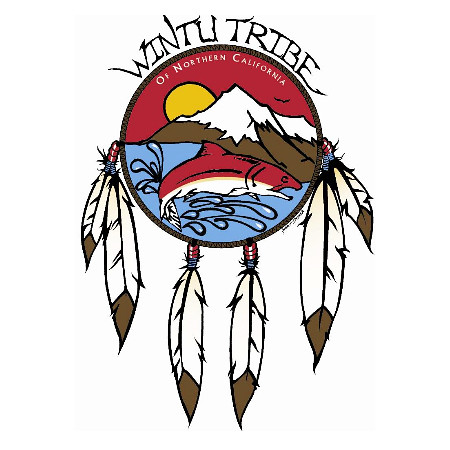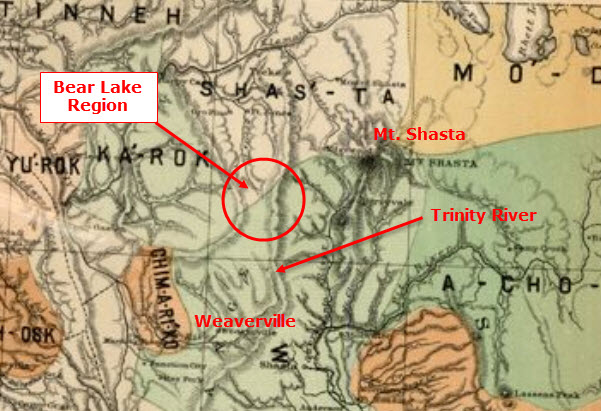(Image Above) Map Showing the Distribution of the Indian Tribes of California (detail, annotated), U.S. Dept. of the Interior, 1877
“All life is sacred. We come into Life as sacred beings.
When we abuse the sacredness of Life we affect all Creation.”
— Chief Arvol Looking Horse
The Wintun Nation
The Wintun (aka Northern Wintu) people were a loose association of human families and related groups that lived in the northern Central Valley of California for over a thousand years. By contrast, the conquering tribe of Americans – I will refer to them as “White People” as the Indians did – have lived in the region for fewer than 200 years as I write this. The traditional hunting and gathering range of the Wintun extended all the way from Clear Lake in the southwest to the Trinity Alps in the northwest, and east to Mt. Lassen and the Sierra foothills down to what is now Chico. They might have been some of the least wanting of all indigenous people who ever walked the earth. Their territory was so rife with edible plants and plentiful game that they rarely had to fight over “ownership,” but simply moved around in little bands as the notion suited them.
The happy and satisfied Wintun never developed a need for the written language, agriculture, class distinctions, or cultural dominion, the way that “civilized” people did. Human history has demonstrated that civilizations develop around the premise of need or want. Since what is pompously referred to as the “dawn of civilization,” the strong who want more have usually organized a way to take it from the weak.
The Wintun mythology was deep with the sense that the land itself was full of spirits. Such bounty deserved special recognition. Trees, plants, animals, mountains, and even prominent rocks were given names and personalities. Stories about their origin were handed down carefully from generation to generation like a kind of natural encyclopedia. They had lots of time for stories and their favorite pastime of gambling, because they knew they could go out and get food as easily as the modern housewife drives to the market. In their highly competitive and energetic gambling games, the gain or loss of goods, or “wealth,” was not the main objective. The contest itself was the important thing; especially how well it was played. If one lost everything, one could simply go and hunt or gather abundant food so the loser had no sense of enduring loss. The land was their wealth, but they did not have a concept of “ownership” of the land. They considered themselves caretakers, and just one example of how they “walked the talk” was their husbandry of the forests and woodlands. They would regularly clear dead brush and limbs, and even organize control burns to prevent the catastrophic wildfires that plague California in modern times.
For the Northern Wintun, the first fateful contact with the White People was probably the expedition of Jedidiah Smith in 1826. Shortly after that and other encounters with trappers, a smallpox epidemic wiped out nearly 75% of the indigenous people in Northern California. It turned out that the “soft” Indians who flourished in paradise had poorly developed immune systems. The aggressive prospectors and settlers of the White People tribe that later invaded their territory thought that the Wintun were the laziest Indians they had ever seen. They scornfully referred to them as “Digger Injuns” for their habit of casually digging up edible roots and tubers with any stick lying about. Their apparent lack of ambition led the White People to believe they were weak and stupid, and could easily be taken advantage of. The remaining Wintun were naturally trusting like children, for there was plenty of food for everyone, and the climate was hospitable. They obligingly let the White People settle on their land, expecting them of course to share the natural bounty. We all know that didn’t work out well for the natives.
After gold was found in the Trinity Alps, things went from bad to worse for the locals. In their avaricious haste, the White People couldn’t get those good-for-nothing natives out of the way fast enough. They concocted horrific stories of “wild Indians” and exterminated hundreds of men, women, and children in retaliation for imagined or inflated crimes. They even staged a diabolically fake “friendship feast” in 1850, and invited all the local Indians. The food itself was poisoned, and over a hundred Indians died horrible, wasting deaths. With the pesky savages out of the way, the White People manifestly seized control of all the land they wanted. They hosed the precious yellow metal out of the mountains with gigantic hydraulic cannons that gouged away the thin forest topsoil, destroying the local ecology and silting up the creeks and rivers so that salmon and steelhead could not spawn. They made the resources scarce enough that they had to be “managed” by an organized government. The days of plenty were over, unless you were rich and belonged to the victorious tribe. In the vile tradition of the conquistadores in South America, the White People forced the local Indians into slavery, putting their digging tendencies to good use in their mines to extract the riches from the land they once roamed freely.
The Wintun people, ravaged by insidious illnesses brought by the invaders, and deprived of a natural provenance on which they had depended for over a thousand years, dwindled drastically in number. By 1910, fewer than 15 individuals could truly call themselves Wintun. Lately, they have made a comeback in numbers, and have even enacted a form of revenge on the White People via the Indian Gaming Act. It seems they have put their love of gambling to good use. They operate a very successful resort, golf course, and casino at Cache Creek in the west Central Valley, all of which specialize in efficiently separating the White People from their excess cash. So the gold is being returned to the people whose ancestors took care of the land from whence it came – one poker chip at a time. The comic irony is that the vicious avarice that caused the White People to cruelly dominate in the past is the now the one that slowly bleeds them of their wealth. The tragedy is that their greed will also someday destroy the Wintun homeland once and for all.

“The ‘untouched wilderness’ myth renders invisible the practices and world views of indigenous peoples who have lived in, cared for, as well as co-created the forests and other so-called wilderness places.”
— Frederíque Apffel-Marglin
Backpacking reminds me of my own inadequacy as a member of the White People tribe. The fact that I need to pack in freeze dried food, clothing, special hiking boots — basically everything I need — illustrates how far removed I am from the natural world. The native humans who survived in this area did so without the benefit of “technology” or artificially prepared aids of any kind. Everything they needed was fashioned from the world around them. Which is the superior form of conquest?
The implements of “civilization” that I must carry to survive in the natural world are wrought from the sacrifices of other living things. That is how my tribe survives. We rape the planet and its life forms for their natural resources so that we can make more convenient lives for ourselves. Every article of nylon, every plastic gadget, every product in its package, originated from the collective energies of billions of other organisms. It is a remarkable irony that a race that considers itself superior to all others must depend upon the exploitation of countless other beings to sustain its own existence in the so-called “natural world.” Contrast that with the native humans, who existed solely from their own energies, and what they could personally collect from the environment, and my tribe’s inferiority is absolute.
By learning to love and understand the land in one concentrated area, I have realized the depth of suffering of displaced indigenous people such as the Native American tribes and extended family groups of Northern California. My race is merely the latest, fiercest tribe. The strong displacing the weak has been the central theme of human social history from its genesis, and is implicit in the dominant biological paradigm we call ‘natural selection.’ However, when I realized firsthand the feelings that one can develop for a place over time, I understood how devastating it is to the soul to be unraveled from one’s natural place in the earthly tapestry. The enchantment and exhilaration of the Bear Lakes and the surrounding scenic wilderness has surely been an attraction for thousands of years of human visitation in the area. In humble recognition, I dedicate this blog, and my life, to the Old Ones who still walk these trails.
“Crazy Horse dreamed and went into the world where there is nothing but the spirits of all things. That is the real world that is behind this one, and everything we see here is like a shadow from that world.”
— Black Elk

